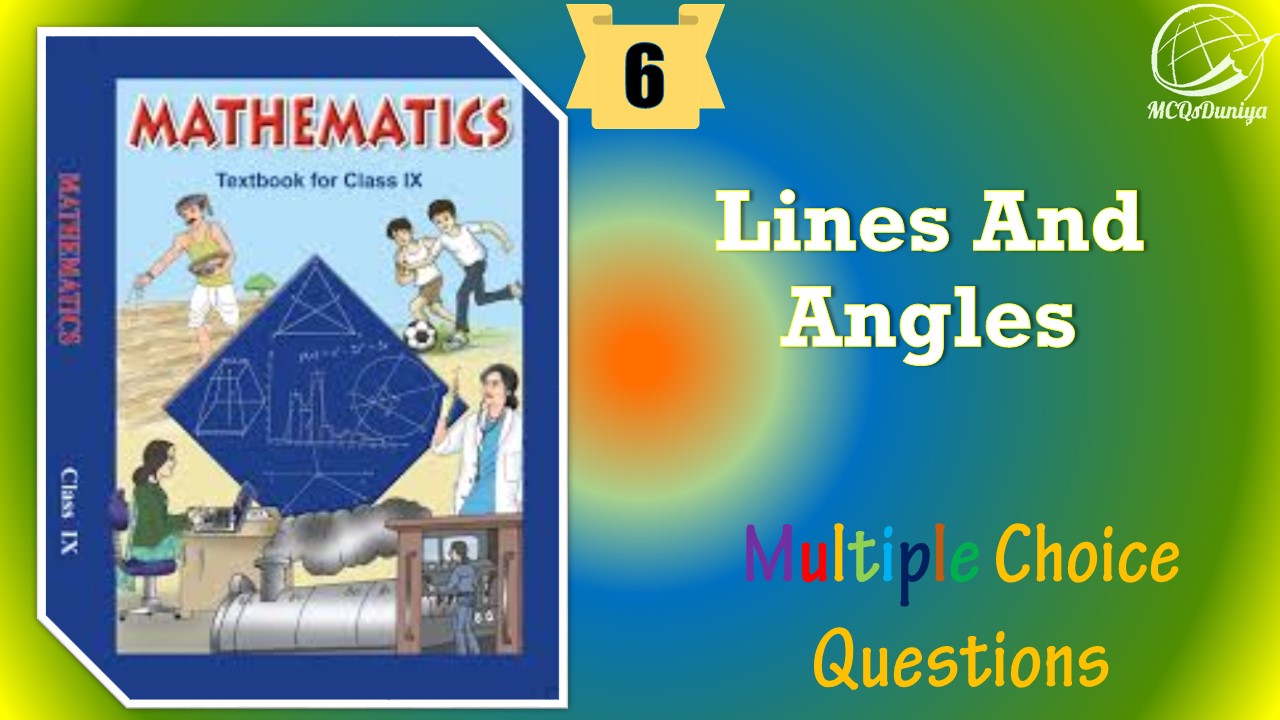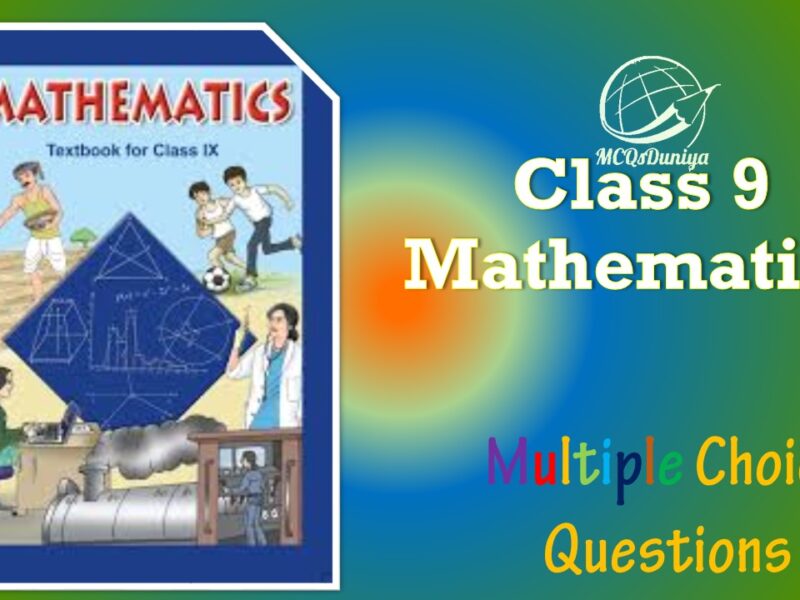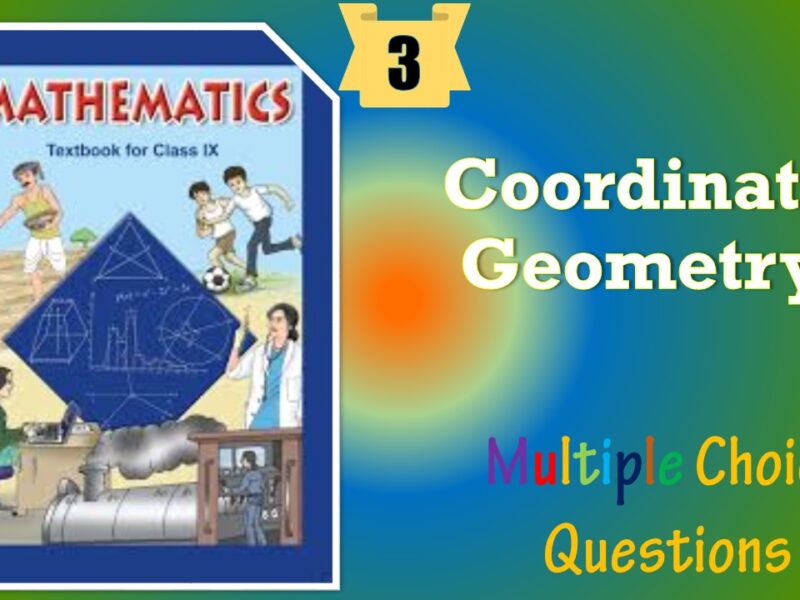Class 9 Mathematics MCQ Lines And Angles with Answers is Prepared Based on Latest Exam Pattern. Students can solve NCERT Class 9 Mathematics MCQ Lines And Angles with Answers to know their preparation level.
Students who are searching for NCERT Class 9 Mathematics MCQ Lines And Angles with Answers are compiled here to get good practice on all fundamentals. Know your preparation level on MCQ Questions for Class 9 Mathematics MCQ Lines And Angles with Answers. You can also verify your answers from the provided Class 9 Mathematics MCQ Lines And Angles with Answers. So, ace up your preparation with MCQ of Class 9 Mathematics MCQ & NCERT Textbook solutions Examinations.
NCERT Class 9 Mathematics MCQ Lines And Angles with Answers
Question :Sum of the measure of an angle and its vertically opposite angle is always.
(a) Zero
(b) Thrice the measure of the original angle
(c) Double the measure of the original angle
(d) Equal to the measure of the original angle
Answer : (c) Double the measure of the original angleShow Answer :
Question :If two parallel lines are cut by a transversal, then the pairs of corresponding angles are congruent.
(a) Equal
(b) Complementary
(c) Supplementary
(d) corresponding
Answer : (d) correspondingShow Answer :
Question : A reflex angle is:
(a) More than 90 degrees
(b) Equal to 90 degrees
(c) More than 180 degrees
(d) Equal to 180 degrees
Answer : cShow Answer :
Question : A straight angle is equal to:
(a) 0°
(b) 90°
(c) 180°
(d) 360°
Answer : cShow Answer :
Question : Two angles whose sum is equal to 180° are called:
(a) Vertically opposite angles
(b) Complementary angles
(c) Adjacent angles
(d) Supplementary angles
Answer : dShow Answer :
Question : Intersecting lines cut each other at:
(a) One point
(b) Two points
(c) Three points
(d) Null
Answer : aShow Answer :
Explanation: Two lines always intersect each other at one point.
Question : Two parallel lines intersect at:
(a) One point
(b) Two points
(c) Three points
(d) Null
Answer : dShow Answer :
Explanation: If two lines are parallel to each other, they don’t intersect each other.
Question : If two lines intersect each other, then the vertically opposite angles are:
(a) Equal
(b) Unequal
(c) Cannot be determined
(d) None of the above
Answer : aShow Answer :
Explanation: If two lines intersect each other, then the angles formed at the point of intersection are vertically opposite angles and are equal.
Question : In the figure below, which of the following are corresponding angle pairs?
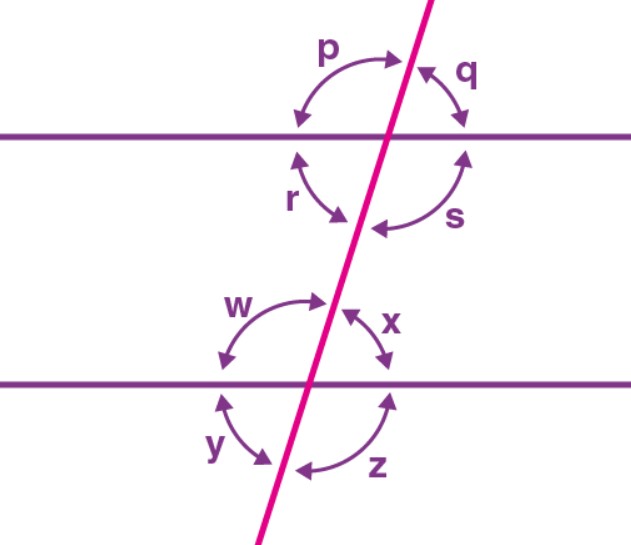
(a) ∠p and ∠q
(b) ∠p and ∠w
(c) ∠p and ∠x
(d) ∠p and ∠z
Answer : bShow Answer :
Question : If AB || CD, EF ⊥ CD and ∠GED = 135° as per the figure given below.
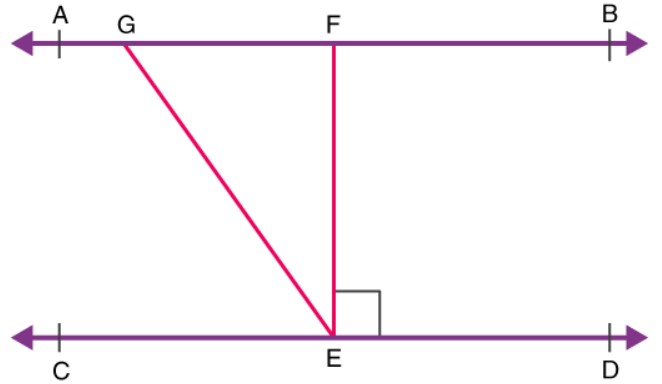
The value of ∠AGE is:
(a) 120°
(b) 140°
(c) 90°
(d) 135°
Answer : dShow Answer :
Explanation: Since AB || CD and GE is transversal.
Given, ∠GED = 135°
Hence, ∠GED = ∠AGE = 135° (Alternate interior angles)
Question :The bisectors of the base angles of an isosceles triangle ABC, with AB = AC, meet at O. If ∠B = ∠C = 50°. What is the measure of angle O?
(a) 120°
(b) 130°
(c) 80°
(d) 150°
Answer : (b) 130°Show Answer :
Question :The angles of a triangle are in the ratio 2 : 3 : 4. The angles, in order, are :
(a) 80°, 40°, 60°
(b) 20°, 60°, 80°
(c) 40°, 60°, 80°
(d) 60°, 40°, 80°
Answer : (c) 40°, 60°, 80°Show Answer :
Question :An acute angle is:
(a) More than 90 degrees
(b) Less than 90 degrees
(c) Equal to 90 degrees
(d) Equal to 180 degrees
Answer : (b) Less than 90 degreesShow Answer :
Question :Two parallel lines intersect at:
(a) One point
(b) Two points
(c) Three points
(d) Null
Answer : (d) NullShow Answer :
Question :The angle between the bisectors of two adjacent supplementary angles is :
(a) Acute angle
(b) Right angle
(c) Obtuse angle
(d) None of these
Answer : (b) Right angleShow Answer :
Question :Two angles whose measures are a & b are such that 2a – 3b = 60° then 5b = ?, if they form a linear pair:
(a) 120°
(b) 300°
(c) 60°
(d) None of these
Answer : (b) 300°Show Answer :
Question :An angle is 14° more than its complementary angle, then angle is :
(a) 38°
(b) 52°
(c) 50°
(d) None of these
Answer : (b) 52°Show Answer :
Question :Find the measure of the angle which is complement of itself.
(a) 30°
(b) 90°
(c) 45°
(d) 180°
Answer : (c) 45°Show Answer :
Question :X lies in the interior of ∠BAC. If ∠BAC = 70° and ∠BAX = 42° then ∠XAC =?
(a) 28°
(b) 29°
(c) 27°
(d) 30°
Answer : (a) 28°Show Answer :
Question :Which of the following statements is false?
(a) A line can be produced to any desired length.
(b) Through a given point, only one straight line can be drawn.
(c) Through two given points, it is possible to draw one and only one straight line
(d) Two straight lines can intersect in only one point
Answer : (b) Through a given point, only one straight line can be drawn.Show Answer :
Question :Two parallel lines have:
(a) A common point
(b) Two common points
(c) No common point
(d) Infinite common points
Answer : (c) No common pointShow Answer :
Question :If a side of a triangle is produced, then the exterior angle so formed is equal to the sum of the ____ interior opposite angles.
(a) Two
(b) Four
(c) One
(d) Three
Answer : (a) TwoShow Answer :
Question :If two straight lines are perpendicular to a line l, then they are.
(a) The lines intersect each other when extended
(b) Parallel to each other
(c) The angle between the two lines is 180°
(d) Perpendicular to each other
Answer : (b) Parallel to each otherShow Answer :
Question : An acute angle is:
(a) More than 90 degrees
(b) Less than 90 degrees
(c) Equal to 90 degrees
(d) Equal to 180 degrees
Answer :(b)Less than 90 degreesShow Answer :
Question : An angle is 14° more than its complementary angle, then angle is :
(a) 38°
(b) 52°
(c) 50°
(d) None of these
Answer :(b) 52°Show Answer :
Question : If one angle of triangle is equal to the sum of the other two angles then triangle is :
(a) Acute triangle
(b) Obtuse triangle
(c) Right triangle
(d) None of these
Answer :(c) Right triangleShow Answer :
Question : If two lines intersect each other, then the vertically opposite angles are:
(a)Equal
(b)Unequal
(c)Cannot be determined
(d)None of the above
Answer :(a)EqualShow Answer :
Question : The angle of a triangle are in the ratio 5 : 3 : 7, the triangle is
(а) an acute-angled triangle
(b) an obtuse angled triangle
(c) an right angled triangle
(d) an isosceles triangle.
Answer :(а) an acute-angled triangleShow Answer :
Question :Two lines are parallel to each other, only when
(a) They do not intersect each other when extended on either side
(b) The lines lie on the same plane
(c) They are parallel to the plane in which they lie
(d) Their point of intersection is a unique point
Answer : (a) They do not intersect each other when extended on either sideShow Answer :
Question :If two lines intersect each other, then the vertically opposite angles are:
(a) Equal
(b) Unequal
(c) Cannot be determined
(d) None of the above
Answer : (a) EqualShow Answer :
Question : In a triangle ABC if ∠A = 53° and ∠C = 44° then the value of ∠B is:
(a) 46°
(b) 83°
(c) 93°
(d) 73°
Answer :(b) 83°Show Answer :
Question : Two parallel lines intersect at:
(a)One point
(b)Two points
(c)Three points
(d)Null
Answer :(d)NullShow Answer :
Question : An exterior angle of a triangle is 80° and the interior opposite angles are in the ratio 1 : 3, measure of interior opposite angles are
(a) 30°, 90°
(b) 40°, 120°
(c) 20°, 60°
(d) 30°, 60°
Answer :(c) 20°, 60°Show Answer :
Question : X lies in the interior of ∠BAC. If ∠BAC = 70° and ∠BAX = 42° then ∠XAC =?
(a) 28°
(b) 29°
(c) 27°
(d) 30°
Answer :(a) 28°Show Answer :
Question : Given four points such that no three of them are collinear, then the number of lines that can be drawn through them are:
(a) 4 lines
(b) 8 lines
(c) 6 lines
(d) 2 lines
Answer :(c) 6 linesShow Answer :
Question : In the given figure, , if AB || CD || EF, PQ || RS, ∠RQD = 25° and ∠CQP = 60°, then ∠QRS is equal to
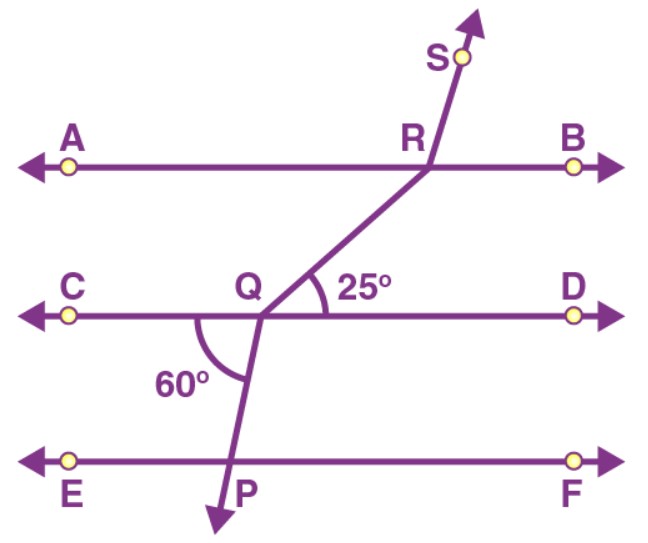
(a) 85°
(b) 110°
(c) 135°
(d) 145°
Answer :dShow Answer :
Explanation: Given that, AB || CD || EF, PQ || RS, ∠RQD = 25° and ∠CQP = 60°.
To find: ∠QRS.

∠CQP + ∠CQT=180 (Linear Pair)
60°+ ∠CQT=180
∠CQT = 180-60
∠CQT=120°
∠CQT = ∠ATU (Corresponding Angles)
∠ATU=120°
∠ARS = ∠ATU (Corresponding Angles)
∠ARS = 120°
∠QRA =∠RQD=25°
Hence, ∠QRS = ∠ARS+∠QRA = 120°+25°
∠QRS = 145°
Question : An obtuse angle is
(a) Less than 90°
(b) Greater than 90°
(c) Equal to 90°
(d) Equal to 180°
Answer : bShow Answer :
Explanation: An obtuse angle is an angle that is greater than 90° and less than 180°.
Question : In the given figure, if OP||RS, ∠OPQ = 110° and ∠QRS = 130°, then ∠PQR is equal to
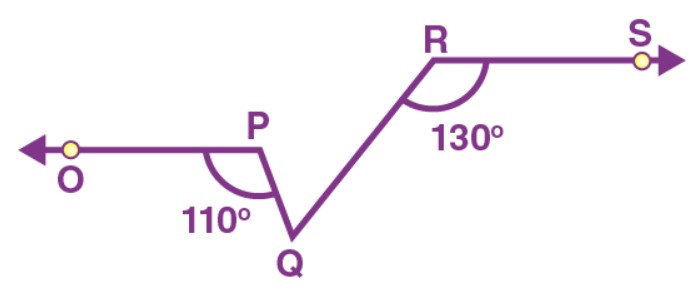
(a) 40°
(b) 50°
(c) 60°
(d) 70°
Answer :cShow Answer :
Explanation:
Now, consider the figure,

Using, OP || RS, we know that,
SRW+ RWV=180° (Co Interior> Angles)
∠RWV = 180°- 130°
Hence, ∠RWV = 50°
Since opposite angles of intersecting lines are equal,
∠PWQ = ∠RWV = 50°
For line OP
∠OQP + θ = 180° [Straight angle]
θ = 180° – ∠OPQ = 180° − 110°
θ = 70°
Now, by using the fact, that the sum of interior angles of a triangle is 180°, we can write
∠PQR + θ + ∠PWQ = 180°
∠PQR = 180°- θ – ∠PWQ = 180°- 70°- 50°
∠PQR = 180° − 120°
∠PQR = 60°
Hence, ∠PQR is equal to 60°.
Question : If two parallel lines are cut by a transversal, then the pairs of corresponding angles are congruent.
(a) Equal
(b) Complementary
(c) Supplementary
(d) corresponding
Answer :(d) correspondingShow Answer :
Question : An acute angle is:
(a)More than 90 degrees
(b)Less than 90 degrees
(c)Equal to 90 degrees
(d)Equal to 180 degrees
Answer :(b)Less than 90 degreesShow Answer :
Question : One of the angles of a triangle is 75°. If the difference of other two is 35°, then the largest angle of other two angles has a measure
(a) 80°
(b) 75°
(c) 70°
(d) 135°
Answer :(c) 70°Show Answer :
Question : The angles of a triangle are in the ratio 5 : 3: 7. The triangle is
(a) a right triangle
(b) an acute-angled triangle
(c) an obtuse-angled triangle
(d) an isosceles triangle
Answer :bShow Answer :
Explanation: If the angles are in the ratio of 5:3:7,
We know that the sum of the interior angles of a triangle is 180°
Therefore, 5x+3x+7x = 180°
15x = 180°
x = 180°/15 = 12°
Thus, 5x = 5(12°) =60°
3x = 3(12°) =36°
7x = 7(12°) =84°
Since all the angles are less than 90°, the triangle is an acute angle triangle.
Question : Angles of a triangle are in the ratio 2: 4 : 3. The smallest angle of the triangle is
(a) 20°
(b) 40°
(c) 60°
(d) 80°
Answer :bShow Answer :
Explanation:
We know that the sum of the interior angles of a triangle is 180°
Given that, the angles of a triangle are in the ratio of 2:4:3
By using the angle sum property of the triangle
2x+4x+3x = 180°
9x = 180°
x= 20
Therefore,
2x = 2(20) = 40°
4x = 4(20) = 80°
3x = 3(20) = 60°
Hence, the angles are 40°, 80° and 60°.
Therefore, the smallest angle of a triangle is 40°.
Question : In the given figure, POQ is a line. The value of x is

(a) 20
(b) 25
(c) 30
(d) 35
Answer :aShow Answer :
Explanation:
Given that POQ is a line. Hence, POQ = 180°
Therefore, 40°+4x+3x = 180°
7x = 180-40
7x = 140
x = 140/7
x = 20
Hence, the value of x is 20.
Question :In the adjoining figure, ABC is a triangle in which D and E are teh mid points of AB ad AC respectively. IF BC = 4.6 cm then DE = _____
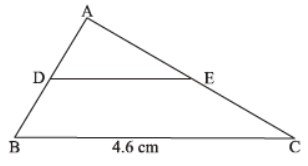
- a) 9.2 cm
- b) 5.0 cm
- c) 2.3 cm
- d) 6.4 cm
Show Answer :
Answer : 9.2 cm
Question :In a ΔABC, D is any point on AB and DE || BC meets AC at E. IF Ad = 2.5 cm, DB = 6 cm and AE = 3 cm then AC =
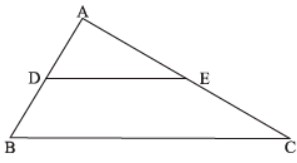
- a) 10.2 cm
- b) 12 cm
- c) 8.5 cm
- d) 5 cm
Show Answer :
Answer : 10.2 cm
Question :In the given figure, EF ||AD and ED || AC. If BF = 4 cm, FD = 6 cm and BE = 8 cm, then BC = ____
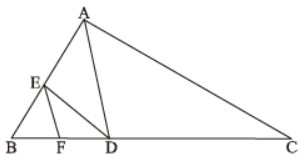
- a) 25 cm
- b) 12 cm
- c) 15 cm
- d) none
Show Answer :
Answer : 25 cm
Question :
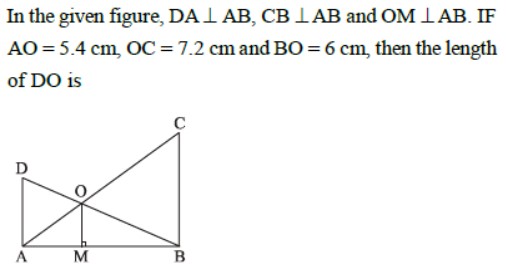
- a) 5 cm
- b) 4.5 cm
- c) 4 cm
- d) 6.5 cm
Show Answer :
Answer : 5 cm
Question :ABCD is a quadrilateral piece of land in which DC = 309 m. The land has been dividied into three parts as shown in the figure. If DA || EO || FH || BC, AG = 5 m, GH = 8 m and HB = 12 m then the length of DE
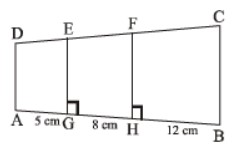
- a) 6 m
- b) 4 m
- c) 3 m
- d) 5 m
Show Answer :
Answer : 6 m
Question :If lines AB, AC, AD and AE are parallel to a line l, then_________.
- a) A, B, C, D, E are collinear points
- b) A, B, C, D, E are noncollinear points
- c) AB and AC are parallel and AD and AE are perpendicular
- d) none of these
Show Answer :
Answer : A, B, C, D, E are collinear points
Question :If two lines are perpendicular to the third line, then those two lines are
- a) parallel to each other
- b) neither parallel nor perpendicular
- c) perpendicular to each other
- d) either parallel or perpendicular
Show Answer :
Answer : parallel to each other
Question :IF ABCD is a quadrilateral and E, F, G, H are the midpoints of AB< BC, CD and DA respectively, then EFGH is a
- a) parallelogram
- b) square
- c) rectangle
- d) rhombus
Show Answer :
Answer : parallelogram
Question :

- a) 55°
- b) 90°
- c) 60°
- d) 70°
Show Answer :
Answer : 55°
Question :
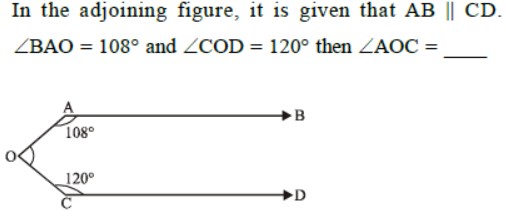
- a) 132°
- b) 120°
- c) 72°
- d) 150°
Show Answer :
Answer : 132°
Question :In the adjoining figure, it is given that ; || m, t is a transversal. Then the value of X is

- a) 130°
- b) 50°
- c) 120°
- d) None
Show Answer :
Answer : 130°
Question :
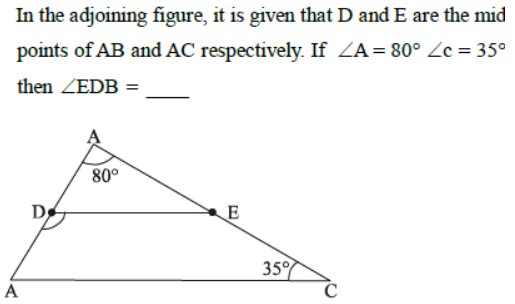
- a) 115°
- b) 160°
- c) 120°
- d) 70°
Show Answer :
Answer : 115°
Question : Sum of the measure of an angle and its vertically opposite angle is always.
(a) Zero
(b) Thrice the measure of the original angle
(c) Double the measure of the original angle
(d) Equal to the measure of the original angle
Answer :(c) Double the measure of the original angleShow Answer :
Question : Two lines are parallel to each other, only when
(a) They do not intersect each other when extended on either side
(b) The lines lie on the same plane
(c) They are parallel to the plane in which they lie
(d) Their point of intersection is a unique point
Answer :(a) They do not intersect each other when extended on either sideShow Answer :
Question : The angles of a triangle are in the ratio 2 : 3 : 4. The angles, in order, are :
(a) 80°, 40°, 60°
(b) 20°, 60°, 80°
(c) 40°, 60°, 80°
(d) 60°, 40°, 80°
Answer :(c) 40°, 60°, 80Show Answer :
Question : If AB = x + 3, BC = 2x and AC = 4x – 5, then for what value of ‘x’, B lies on AC?
(a)2
(b)3
(c)5
(d)8
Answer :(d)8Show Answer :
Question : Each angle of an equilateral triangle is
(a) 50°
(b) 90°
(c) 54°
(d) 60°
Answer :(d) 60°Show Answer :
Question : If one angle of triangle is equal to the sum of the other two angles then triangle is :
(a) Acute triangle
(b) Obtuse triangle
(c) Right triangle
(d) None of these
Answer :(c) Right triangleShow Answer :
Question :In a right-angled triangle where angle A = 90° and AB = AC. What are the values of angle B?
(a) 45°
(b) 35°
(c) 75°
(d) 65°
Answer : (a) 45°Show Answer :
Question :In a triangle ABC if ∠A = 53° and ∠C = 44° then the value of ∠B is:
(a) 46°
(b) 83°
(c) 93°
(d) 73°
Answer : (b) 83°Show Answer :
Question :Given four points such that no three of them are collinear, then the number of lines that can be drawn through them are:
(a) 4 lines
(b) 8 lines
(c) 6 lines
(d) 2 lines
Answer : (c) 6 linesShow Answer :
Question :If one angle of triangle is equal to the sum of the other two angles then triangle is :
(a) Acute triangle
(b) Obtuse triangle
(c) Right triangle
(d) None of these
Answer : (c) Right triangleShow Answer :
Question :How many degrees are there in an angle which equals one-fifth of its supplement?
(a) 15°
(b) 30°
(c) 75°
(d) 150°
Answer : (b) 30°Show Answer :
Question : If two interior angles on the same side of a transversal intersecting two parallel lines in the ratio 2:3 ,then find the larger of two angles.
(a) 72°
(b) 108°
(c) 54°
(d) 36°
Answer :(b) 108°Show Answer :
Question : Two parallel lines have:
(a) A common point
(b) Two common points
(c) No common point
(d) Infinite common points
Answer :(c) No common pointShow Answer :
Question : In a triangle ABC if ∠A = 53° and ∠C = 44° then the value of ∠B is:
(a) 46°
(b) 83°
(c) 93°
(d) 73°
Answer :(b) 83°Show Answer :
Question : If a transversal intersects two parallel lines, then the consecutive interior angles are
(a) equal
(b) congruent
(c) supplementary
(d) complementary
Answer :(c) supplementaryShow Answer :
Question : If two lines intersect each other, then the vertically opposite angles are:
(a) Equal
(b) Unequal
(c) Cannot be determined
(d) None of the above
Answer :(a) EqualShow Answer :
Question : A line joining two endpoints is called:
(a) Line segment
(b) A ray
(c) Parallel lines
(d) Intersecting lines
Answer : aShow Answer :
Question : An acute angle is:
(a) More than 90 degrees
(b) Less than 90 degrees
(c) Equal to 90 degrees
(d) Equal to 180 degrees
Answer : bShow Answer :
Question : An exterior angle of a triangle is 105° and its two interior opposite angles are equal. Each of these equal angles is
(a) 37 ½°
(b) 72 ½°
(c) 75°
(d) 52 ½°
Answer :dShow Answer :
Explanation:
The exterior angle of triangle = 105°
Let the interior angles be “x”.
By using, exterior angle theorem, Exterior angle = Sum of interior opposite angles
Therefore, 105° = x+x
2x = 105°
x = 52 ½°
Question : If one of the angles of a triangle is 130°, then the angle between the bisectors of the other two angles can be
(a) 50°
(b) 65°
(c) 145°
(d) 155°
Answer :dShow Answer :
Explanation:
Assume a triangle ABC, such that ∠BAC=130°
Also, the bisectors of ∠B and ∠C meet at O.
To find: ∠BOC
In a triangle △ABC,
∠BAC+∠ABC+∠ACB=180°
By using the angle sum property of the triangle,
130°+∠ABC+∠ACB=180°
∠ABC+∠ACB=50°
½ (∠ABC+∠ACB)=25°
Since OB and OC bisect ∠ABC and ∠ACB
∠OBC+ ∠OCB=25°
Now, consider △OBC, by using the angle sum property of the triangle,
∠OBC+ ∠OCB+∠BOC=180°
25°+∠BOC=180°
∠BOC=155°
Question : If two interior angles on the same side of a transversal intersecting two parallel lines are in the ratio 2 : 3, then the greater of the two angles is:
(a) 54°
(b) 108°
(c) 120°
(d) 136°
Answer :bShow Answer :
Explanation: Consider the following figure,
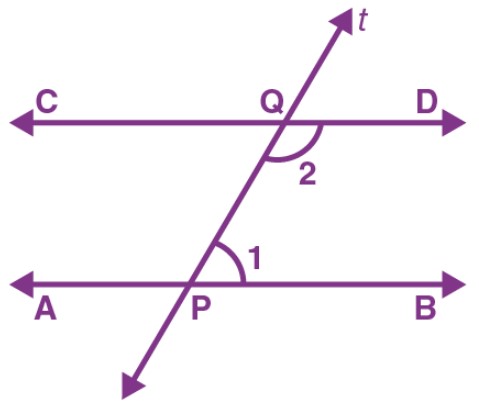
Here, line AB is parallel to the line CD and t is the transversal.
Here, ∠1 and ∠2 are on the same side of the transversal. Hence, ∠1: ∠2 = 2:3
Let ∠1 = 2x and ∠2 = 3x.
Therefore, ∠1+∠2 = 180° (If a transversal intersects two parallel lines, each pair of consecutive angles are supplementary)
On substituting ∠1 = 2x and ∠2 = 3x in the above equation, we get
2x+3x = 180°
5x = 180°
x = 180°/5 = 36°
Hence, 3x >2x. It means ∠2 >∠1
The value of ∠2 = 3(36°) = 108°
Question : If one angle of a triangle is equal to the sum of the other two angles, then the triangle is
(a) a right triangle
(b) an isosceles triangle
(c) an equilateral triangle
(d) an obtuse triangle
Answer :aShow Answer :
Explanation: If one angle of a triangle is equal to the sum of the other two angles, then the triangle is a right triangle. We know that the sum of interior angles of a triangle is equal to 180°. In the right triangle, one angle should be equal to 90°, and the remaining two angles are acute angles, and their sum is equal to 90°.

